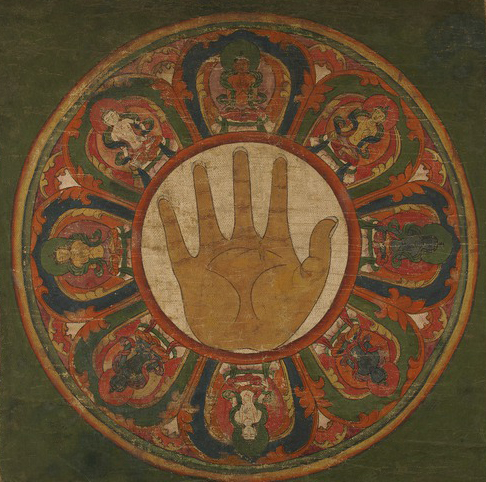
Can motifs connect artworks across place and time? Inspired by our newest exhibition, Henri Cartier-Bresson: India in Full Frame, museum curatorial assistant Amy Goudge makes connections between the iconic photographer’s work and memorable art objects from past Rubin exhibitions.
With the opening of Henri Cartier-Bresson: India in Full Frame, Rubin Museum visitors are offered a glimpse at a rarely seen collection of photographs chosen by the influential French photographer. Composed of sixty-nine photographs from Cartier-Bresson’s travels throughout India, the exhibition also provides insight into a pivotal moment in India’s history that saw widespread changes in the country’s political and social landscapes.
Some photographs in the exhibition include symbols, ideas, and motifs that visitors might recognize from previous exhibitions at the Rubin, reflecting how artist motifs can both endure the test of time, and shift in meaning as the viewer’s frame of reference evolves.
Handprint as Symbol: Henri Cartier-Bresson

The above photograph, taken in Bombay in 1947, captures a scene inside an astrologer’s shop with Cartier-Bresson’s distinctive “street photography” approach. The photograph is evidence of Cartier-Bresson’s mastery of composition and can be read as a triptych with three distinct points of focus: a painted shop sign on the right, describing the astrologer’s services; a figure shown in soft focus on the left, whose lackadaisical stance suggests he may be a customer or friend; and a captivating figure in the central field, who we might assume is the shop-owner from his self-assured posture and gaze.
The open palm featured in the shop sign pays homage to the importance of palm lines in astrology and validates the astrologer’s belief that a human body can be used as a medium for transcendent understanding and prophecy. The photograph also includes an image of a Hindu deity in the background, proposing unexpected layers of hierarchy between secular ritual and devotional faith.
Handprint as Symbol: “Handprint Mandala” from 19th Century Tibet

These features are reminiscent of Handprint Mandala, as pictured below. This object was displayed in the Rubin’s 2005 exhibition, Eternal Presence: Handprints and Footprints in Buddhist Art, which explored the meaning and significance of these symbols in traditional Himalayan art.
In a colloquial sense, the handprint is an instantly recognizable symbol that confers meaning across cultures and times: a symbol for conflicting ideas of human presence and absence, and the passage of time and impermanence.
In Buddhist art and culture, the handprint has appeared from as early as the second century BCE, taking on many different meanings in different contexts. Typically, the handprint is associated with some kind of power and protection, signifying the blessing of a Buddhist practitioner, deity or lama. It may be used to heal the sick, transfer blessings, or ward of negative physical or spiritual energy.
The Handprint Mandala shown below is unusual in that the handprint takes pride of place in the center of the object, a space that’s usually reserved for a rendering of Buddha or a Buddhist deity. The handprint itself is also unusual in that it features palm lines, fingernails, and naturalistic proportions, which we associate with the corporal body rather than a divine being.
These details reflect the same blurring of boundaries between the mortal and the divine, and the secular and sacred, that we can see in Cartier-Bresson’s photograph of the astrologer shop. This connection points at an enduring human curiosity about what might constitute reverence and devotion, and the pursuit of knowledge and self-protection.
Commerce in India and Nepal: Henri Cartier-Bresson

Bresson’s 1948 photograph above, taken in Jaipur, is another example of the artist’s skill at capturing personality through posture, and street life through vignette. Similar to his photograph of the astrologer’s shop, this image features the triangulation of figures that Cartier-Bresson favored in his portraits of street scenes.
The money-changer’s pose creates an intimate connection with the viewer, transporting us into the scene with ease. Like in Cartier-Bresson’s depiction of the astrologer shop, commerce is a central point of our visual focus, with the money-changer’s coins on full display. Industry becomes almost a fourth subject in the portrait, conveying the prominence and visibility of trade in Jaipur’s streets. At the time of this photograph’s distribution, much of Cartier-Bresson’s western audience would’ve had little firsthand knowledge of Indian culture and society. This image would have allowed those audiences a glimpse of life beyond the world they knew, and might have challenged their preconceived notions of cultural difference or similarity.
Commerce in India and Nepal: Genesis Breyer P-Orridge

A similar exploration of trade and social norms can be seen in Genesis Breyer P-Orridge’s series of collages, Beggars and Babas. These works were created for the Rubin Museum’s 2016 exhibition Genesis Breyer P-Orridge: Try to Altar Everything, using photographs that Breyer P-Orridge took during a research trip to Nepal with the exhibition’s curator, Beth Citron, in the Fall of 2015.
Breyer P-Orridge was struck by the ubiquity of beggars on the street in Nepal, and their aesthetic similarity to babas, a group of holy men in Nepal who are devoted to particular Hindu deities. Although babas do solicit material gains just like beggars, they live ascetically and rely on their alms solely for survival. Babas are thought to bring spiritual strength and good karma to their communities, while beggars are typically looked down upon in society.
Breyer P-Orridge cleverly juxtaposes images of beggars and babas to make us question the assumptions we make about character, integrity and good will when confronted with images of poverty and solicitation. The gilded background of the paintings, traditionally used in art to convey subjects of wealth and importance, further encourages viewers to reconsider their understanding of class, social bias, and what it means to be an important member of society.
These two objects, while coming from entirely different contexts, both illustrate what many artists consider central to their vocation: to present images and ideas that serve as a prodding tool for society, a slyly gentle means of exposing our social values, suggesting alternative perspectives, and ultimately expanding our worldview and understanding of what it means to be human.
What connections can you make? See Henri Cartier-Bresson: India in Full Frame, open through September 4, 2017.
About the Author
Amy Goudge is a curatorial assistant at the Rubin Museum of Art. Most recently, she co-curated the “Voice” component of The World is Sound with Risha Lee, and assisted Beth Citron on Henri-Cartier Bresson: India in Full Frame. She holds a Master’s of Visual Arts Administration from New York University.
Header image: Street photographer in the old city. Henri Cartier-Bresson. Delhi, India.1966. ©Henri Cartier-Bresson/Magnum Photos
Henri Cartier-Bresson: India in Full-Frame is organized by the Rubin Museum of Art in collaboration with Magnum Photos and the Henri Cartier-Bresson Foundation. Generous support is provided by The Robert Mapplethorpe Foundation, David Solo, an anonymous donor, and contributors to the 2017 Exhibitions Fund.


